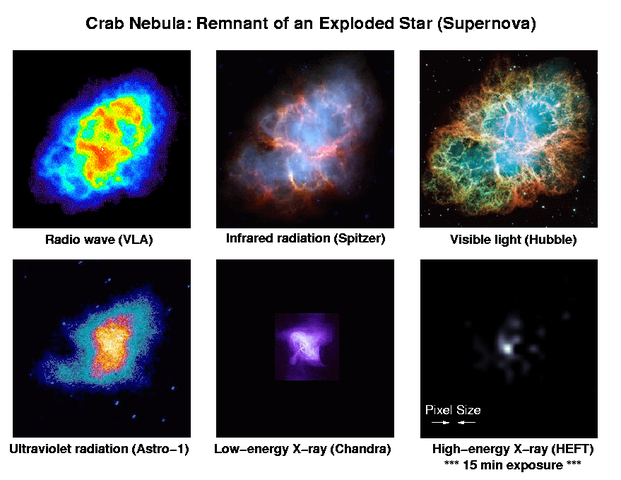 |
This is a file from the Wikimedia Commons. Information from its description page there is shown below.
Commons is a freely licensed media file repository. You can help.
|
Summary
| Description |
English: The High Energy Focusing Telescope (HEFT) is a balloon-borne instrument carrying one of the first focusing telescopes for the hard X-ray band (20–70 keV). It makes use of tungsten-silicon multilayer coatings to extend the reflectivity of nested grazing-incidence mirrors beyond 10 keV. HEFT has an angular resolution of 1.5 arcminutes in half-power diameter, and an energy resolution of 1.0 keV full width at half maximum at 60 keV. HEFT was launched for a 25-hour balloon flight on May 2005. The instrument performed within specification, and observed Cyg X-1, the Crab Nebula.
|
| Date |
10 January 2008 |
| Source |
High Energy Focusing Telescope (HEFT), NASA's Scientific Ballooning Program |
| Author |
CM Hubert Chen, Fiona A. Harrison, Principal Investigator, Caltech Charles J. Hailey, Columbia Principal, Columbia, Finn E. Christensen, DSRI Principal, DSRI, William W. Craig, Optics Scientist, LLNL, Stephen M. Schindler, Project Manager, Caltech |
Permission
( Reusing this file) |
Images produced by NASA are usually free of copyright [...]
|
This is the Crab Nebula in various energy bands, including a hard X-ray image from the HEFT data taken during its 2005 observation run. The angular resolution of HEFT is about 1.5′. Each image is 6′ wide.
Licensing
| Public domainPublic domainfalsefalse |
 |
This file is in the public domain because it was solely created by NASA. NASA copyright policy states that "NASA material is not protected by copyright unless noted". (See Template:PD-USGov, NASA copyright policy page or JPL Image Use Policy.) |
|
|
|
Warnings:
- Use of NASA logos, insignia and emblems are restricted per US law 14 CFR 1221.
- The NASA website hosts a large number of images from the Soviet/ Russian space agency, and other non-American space agencies. These are not necessarily in the public domain.
- Materials based on Hubble Space Telescope data may be copyrighted if they are not explicitly produced by the STScI. See also {{ PD-Hubble}} and {{ Cc-Hubble}}.
- The SOHO (ESA & NASA) joint project implies that all materials created by its probe are copyrighted and require permission for commercial non-educational use.
- Images featured on the Astronomy Picture of the Day (APOD) web site may be copyrighted.
|
File usage
The following pages on Schools Wikipedia link to this image (list may be incomplete):
This file contains additional information, probably added from the digital camera or scanner used to create or digitize it. If the file has been modified from its original state, some details may not fully reflect the modified file.
Through Schools Wikipedia, SOS Children has brought learning to children around the world. By supporting vulnerable children right through to adulthood, SOS Childrens Villages makes a lasting difference to the lives of thousands of people. Education is a key part of our work, and our schools provide high-quality teaching to the children in our care. There are many ways to help with SOS Children.





